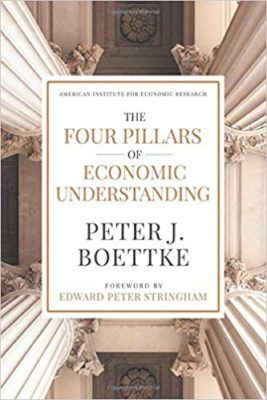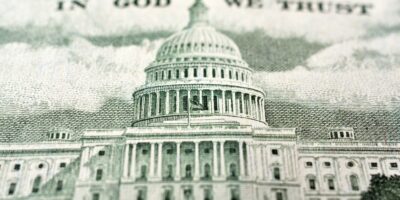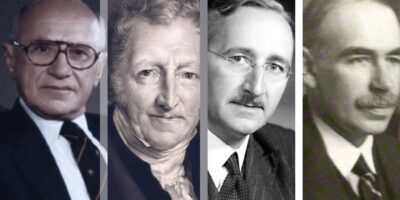Imagine a Horse Race Between Smith, Schumpeter, and Stupidity

Economists have been the object of ridicule for centuries. We supposedly know the price of everything and the value of nothing. The stress on scarcity and choice within constraints is seen as raining on the hope and aspirations for a better world.
In The Four Pillars of Economic Understanding, I try to counter these criticisms by pointing out that the message of basic economics not only provides truth and light to the uninitiated would-be students of society by capturing the beauty of the complex coordination of commercial society. It conveys the hope that entrepreneurship offers for the discovery of new and fascinating products and the implementation of new rules of social interaction which enable productive specialization and peaceful social cooperation.It does so with a sense of deep compassion for the least advantaged, who most benefit from the unleashing of economic forces to alleviate extreme poverty, and raises the material standards of living of people. Economic freedom brings with it progress and peace.
Unfortunately, economics is often taught as an abstract discipline with abstract examples to illustrate. Don’t get me wrong, abstraction is a necessary intellectual tool. Our theories must be logically sound, and as such must be empirically relevant. That requires discipline of thought and expression. Economics is not poetry, and neither is moral philosophy and political economy. We must practice these distinct but related disciplines with the utmost of intellectual care.
Why must we do that, you ask? Wouldn’t it be so much more inspiring to spin fanciful tales of better worlds to inspire the youth?
I want to say NO. James Buchanan, my teacher, argued that what we needed was to articulate a vision in political economy of a “workable utopia”. Hayek earlier had argued that we need a vision of a “liberal utopia,” and that we had to excite the imaginations of the best and the brightest to explore the workings of a free society — a true radical liberalism. But in both Hayek and Buchanan, the idea was to have these “utopias” firmly grounded in the teachings of basic economic reasoning.
As Hayek argued in his 1945 essay “Individualism: True and False,” the idea was to find a social system that relied not on individuals becoming better versions of themselves for its operation, but which made use of individuals as they are — sometimes smart, more often stupid; sometimes good, but capable of being bad. In fact, the idea was to have a system not where the best and the brightest could rule over others, but where bad men if they were to find themselves in charge could do least harm. In this way, freedom could be granted to all, and not restricted to only a few.
This is why Adam Smith’s critical idea of the invisible hand is so vital to our understanding of commercial life. It is not from the benevolence of the butcher, the baker and the brewer that we can expect our dinner, but from appealing to their self-interest. We cannot rely on friendship and fellow feelings to secure for us the material progress required to lift us from the Malthusian trap of subsistence. We escape that Malthusian trap through expansions of the trade and technological innovations spurred by the gains realized from turning scientific knowledge into commercially useful knowledge as the great economic historian Joel Mokyr has so convincingly argued throughout his career. To put it another way, borrowing from Mokyr, there are always headwinds that resist the forces of progress, and tailwinds that push progress forward, and the economic history of humanity is made up of the story of this battle between headwinds and tailwinds.
That metaphor is a useful one to keep in mind when thinking about our current situation, and where the primary winds are coming from — public sector, private sector, independent sector, or some combination. What are the headwinds that seem to block the timely and honest communication of knowledge about public health issues to us, what are the headwinds that delay testing and medical innovations; what are the headwinds that keep the allocation of scarce yet critical medical resources from being allocated to their most urgent use?
On the other hand, where are the tailwinds coming from that will cut against those headwinds and push us forward to make progress against the reality of the current situation? When the history of 2020 comes to be written, obviously a serious accounting of the headwinds and tailwinds will need to take place.
After 2008, in my effort to try to communicate basic economic reasoning to make sense of the reality we were collectively experiencing, I started to utilize my own metaphors and analogies. One was to look at Michael Phelps, the great Olympic swimmer, and to ask my readers to imagine what would happen to his ability to swim across a pool if we first just tied his hands together.
Well it turns out that Phelps gets across the pool in a slower time using the breaststroke than he does freestyle, but still at amazing speed. How about if we tied his feet together as well? Well, again, Phelps is one of the best butterfly swimmers that the world has ever seen, so that dolphin kick would not be impeded by tying his feet together. But again, much slower than his freestyle. How about if we added a 250-pound weight to his waist?
At that point, he would sink to the bottom of the pool. The point I am trying to make however is that you would never say that under those circumstances Phelps’s failure to get across the pool represents swimmer failure. The failure is clearly due to the obstructions placed on his ability to swim. That, I argue, is the error we make when, in the context of highly regulated market economies, we continue as economic educators in discussing “market failure.”
Adam Smith long ago recognized that individuals can find workarounds and ingenious ways to realize gains from trade and gains from innovation even in the presence of what he identified as hundreds of impertinent obstructions which human folly may put in the way.
This led me to articulate another example in hopes of communicating an important economic lesson. To capture the idea of gains from trade and gains from innovation in the face of those impertinent obstructions, I asked readers to envision a horse race between three horses — one named Smith (for gains from trade), a second one named Schumpeter (for gains from innovation), and a third one named Stupidity (for those government-imposed obstructions).
My basic ideas was, following Smith, that as long as the Smith and the Schumpeter horses were running ahead of the Stupid horse, tomorrow will be better than today. The counter-factual is this: what if the Smith and Schumpeter horses were able to run freely, without that Stupid horse biting at their heels and bumping into them rather than staying in their lane.
What I think is important to get from this illustration that is relevant for today is that we aren’t letting the Smith and Schumpeter horse run! They are currently locked in the barn, or trapped behind the start gate. This is why I don’t think the usual Business Cycle story of a cluster of errors being revealed in the bust, and thus a recalculation of ensuing labor and capital is applicable to our understanding of the current situation. It is important for students of economics to remember that in the Austrian theory of the business cycle, the recession is the correction, and the reason is that during the bust phase there is a recalculation of labor and capital to reflect better the preferences and savings and investment trade-offs that individuals are willing to make.
This is decidedly not what is going on at the moment if for no other reason than that the capital and labor is locked up in that barn with Smith and Schumpeter. Don’t misunderstand me, there are serious financial fragilities in the global capitalist system due to policy errors and the manipulation of money and credit combined with fiscal irresponsibility, but that isn’t what is going on right at this precise moment in my humble opinion.
What we are witnessing right now is macroeconomic volatility caused by an exogenous shock due to a public health crisis combined with a policy response that has shut down the economy. Back to my metaphor, while Smith and Schumpeter are trapped in the barn, or at least stuck at the starting gate, the Stupid horse is running freely and getting a lap lead.
Thankfully, those Smith and Schumpeterian horses are younger, fitter, faster and more nimble. Once they are unleashed, it is my sincere hope that they will burst out and catch up quickly to that dumb old hag of a horse Stupidity. They will leave Stupidity in its wake, the accumulated surplus fund will be replenished, and tomorrow will be better than today.
So, let’s get those tailwinds blowing harder than the headwinds, stop tying down our entrepreneurs, and let those Smith and Schumpeter horses run freely. We have to solve a public health crisis, one that requires creative ingenuity and innovation.
We have to restart a stalled economic system; that requires creative and imaginative entrepreneurs. In both cases, our greatest reason for hope is to be found not in bumbling bureaucrats who attempt to lead from ossified institutions of authority, but in the erring entrepreneurs who have their judgements constantly contested by others and only the most nimble and creative are able to negotiate the turbulent times to provide the solution to our woes.











